NorthEast Radio Watch 12/8/2025: Cichon’s Back in Buffalo
In this week’s issue… Veteran newsman returns - Remembering NY's Leitner, RI's Jones - CT AM saved - Maine AM moves - "Indie" adds suburban signals
Text and photos by SCOTT FYBUSH
Growing up an hour and a half from the Canadian border, crossing back and forth is a pretty routine thing for me. So it’s always exciting when friends who aren’t as accustomed to the crossing come to town, allowing me to take them over to see interesting things in Canada.
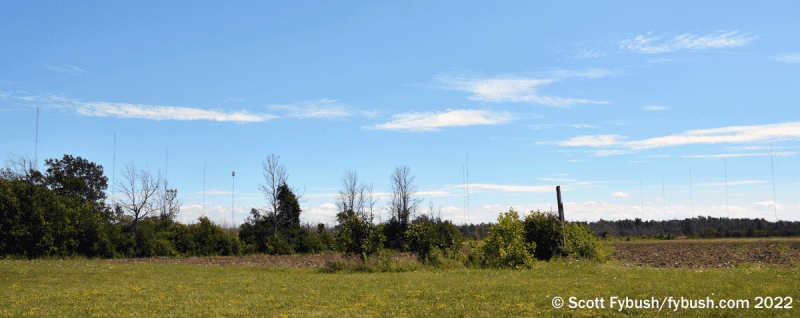
Last summer’s visit from NECRAT’s Mike Fitzpatrick took him across the border for the first time, crossing the Peace Bridge from Buffalo into Fort Erie, Ontario – where it’s just a few minutes down Highway 3 to the closest big Canadian site to the border.
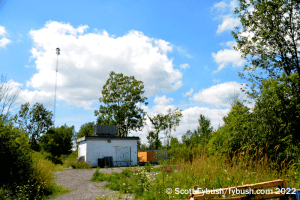
The commercial sprawl of Fort Erie is rapidly spreading out here toward Kraft Road, where it might eventually claim the huge piece of land that’s been sitting largely unused since 2012, when CJRN (710 Niagara Falls) left the AM dial, ending a history that went back to 1947 and Niagara Falls’ original AM station, CHVC (1600). CHVC moved to 710 from this site in 1970, using 12 towers for what was eventually a 10,000-watt day and 5,000-watt night signal that had to provide a deep null to co-channel WOR in New York.
In 1986, a second AM signed on here, Fort Erie’s CJFT (530). It moved to 101.1 a few years later, becoming today’s CFLZ (101.1 More FM). It still uses this site, with a panel antenna mounted atop one tower close to the transmitter building reaching not only Fort Erie and vicinity but also nearby Buffalo. Those other 11 towers? They just sit there unused for now, a memory of the old AM days at this site.
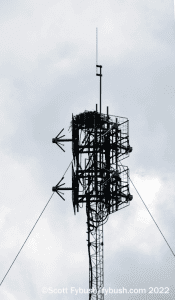
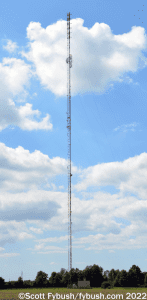

Moving north and west from the old CJRN site takes us to a much newer site that also has plenty of history behind it. In 1999, this tower off County Road 27 east of Welland went on the air as CHOW-FM (91.7), replacing a Welland AM station, CHOW (1470), that had been on the air since 1957. Within a few years, it had settled in with a popular classic rock format as CIXL, “Giant FM” (XL=”giant,” get it?), and in 2014 it added a new sister station here, country CKYY (89.1), operating from a separate panel antenna lower on the tower.
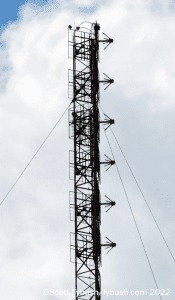
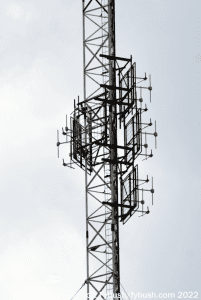
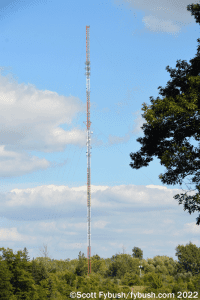
As close as we are to the bustle of Niagara Falls and Buffalo, this part of the Niagara Peninsula is surprisingly rural, in part because a lot of the land here between the Welland Canal and the Niagara River is used for hydro generation and nature preserves.
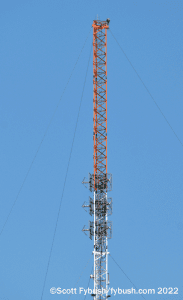
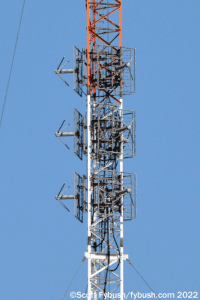
Getting to our next destination takes a bit of a hike, a mile or so down a trail that runs alongside Lake Gibson and the nearby Welland Canal to bring us to a clearing with a view across the water to the little island where the tower of CJED (105.1 Niagara Falls) sits.
“The River” is the descendant of a quirky little tourist information signal, the old CFLZ (91.9) that transmitted from the heart of Niagara Falls, Ontario atop the Skylon Tower starting in 1992. CFLZ was bumped to 105.1 in 1998 when CHOW moved to 91.7, and in 2009 it moved to this site, where it’s now “105.1 the River,” a sister station to the current CFLZ on 101.1
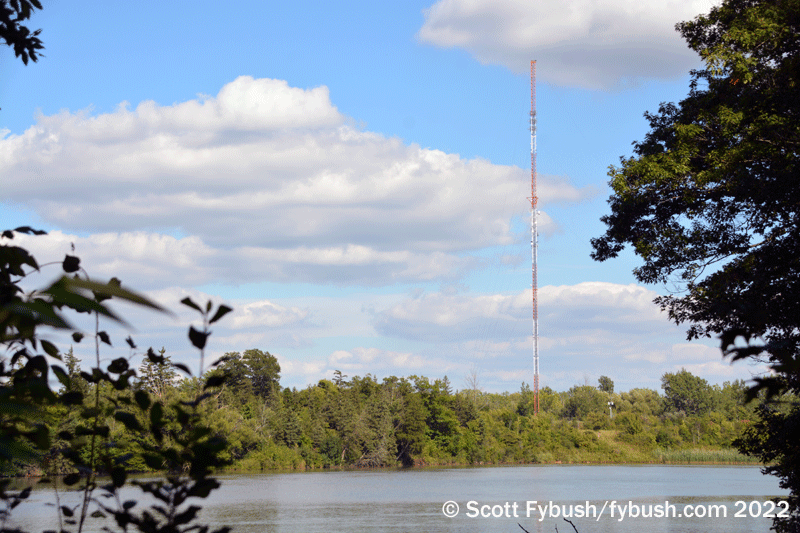
The biggest population center in Niagara Region is St. Catharines, which sits at the northern end of the Welland Canal where it empties into Lake Ontario. It’s one of the oldest radio communities in Canada, boasting a history that goes back to 1930 and the debut of CKTB, now 93 years old and counting.

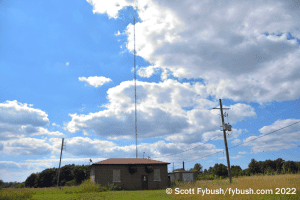
CKTB has been at its current site off McKenney Road just south of the Welland River since 1950, but not without some changes. It signed on here back then at 620 on the dial, having been bumped from 1550 so the CBC could use that frequency in Windsor for its new station, CBE. But 620 turned out to be a poor choice, too close to WHEN in Syracuse, and so by the end of the decade CKTB had moved to its present 610, adding a fifth tower and increasing power to 10,000 watts day and night.
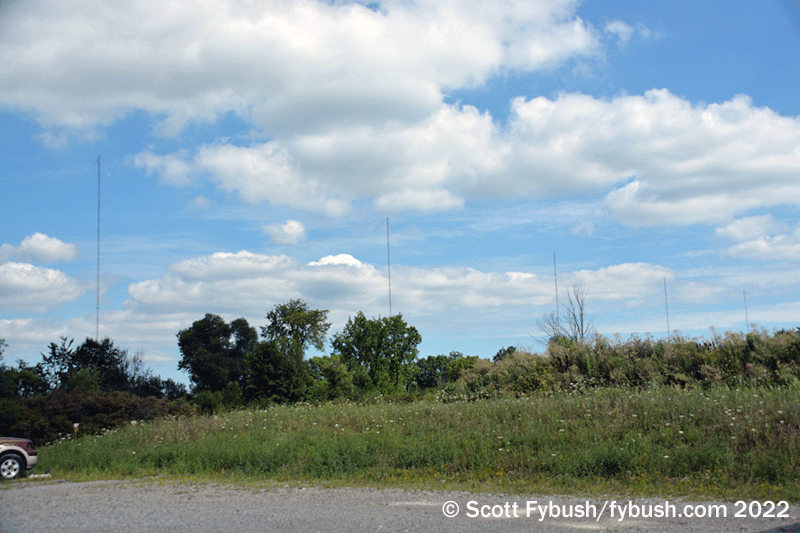
A second AM station came later to St. Catharines: CHSC (1220) hit the air in 1967 as a daytimer, expanding to 10,000 watts day and night in 1978 from a new nine-tower site off Turner Road on the west side of the Welland Canal between St. Catharines and Welland. The station eventually got into trouble with the CRTC for targeting audiences in Toronto instead of Niagara, leading to the loss of its license in 2010 – but the transmitter site remained, making it possible for a new station, CFAJ, to be licensed from the same site with the same 10,000-watt facility. It began testing in 2020, and has still yet to begin full commercial operation, running an automated oldies format without much of a staff or studios, as best we can tell.
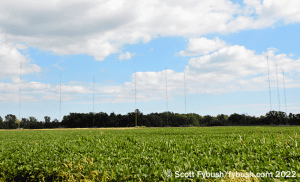
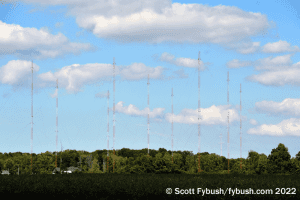
We didn’t get deep into the CFAJ site, but even from a distance a long lens allows a view to the unusual elevated ground system at the base of each of the nine towers.
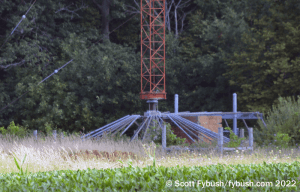
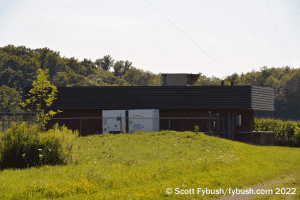
When CHSC signed on in 1967, it debuted an FM station on the same day, CHSC-FM (105.7). Over the decades, the FM eventually split away from the AM, becoming CHRE and ultimately becoming a sister station to CKTB and its own FM sister, CHTZ (97.7).
CHTZ had been around since 1949, when it hit the air as CKTB-FM, a low-power simulcast of the AM, and it wasn’t until 1975 that it became a high-powered signal from this tower site on Cataract Road, just south of Decew Falls.
Today, CHRE (“105.7 Move FM”) shares that tower with CHTZ. It’s just a few kilometers away from the 1220 site and just a few minutes’ drive away, unless you do what we did and take a wrong turn. It’s a good thing Mike drives a Jeep, because we ended up banging our way down a dirt road to emerge near the shared 97.7/105.7 tower, where both stations are diplexed into a 12-bay main antenna, with a three-bay aux down below. These are potent signals, reaching all the way from Buffalo to Hamilton to Toronto most days. (They also have a very historic studio facility, which we’ll show you in a later installment.)
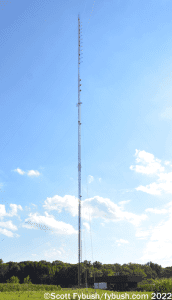
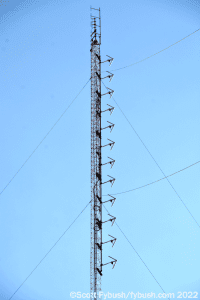
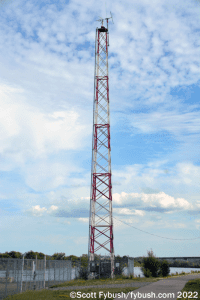
There’s one more little signal that we had to see before leaving the area on the last day of our trip. The Welland Canal is a vital part of the St. Lawrence Seaway system, allowing freighters from the upper Great Lakes to bypass Niagara Falls to get from Lake Erie into Lake Ontario and ultimately out to the Atlantic Ocean.
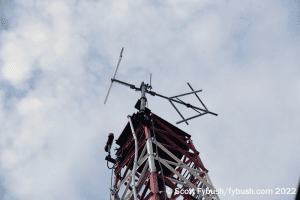
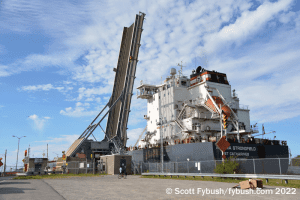
When those big ships go through, though, they disrupt the drive for Niagara Region residents who need to know when the bridges over the canal will be up, sending them on detour routes that include the high-level St. Catharines Skyway that carries the QEW superhighway, or the several tunnels that go under (!) the canal near Welland.
How does that information get out? For the last few years, it’s included an automated FM signal, CFBN (93.3), with a nonstop loop of “Bridge 1, Lakeshore Road, is… available.”
A little hike up along the canalside trail near that Lakeshore Road bridge brings us to the short tower topped by CFBN’s antenna – and as we’re walking, we get to see the bridge open so that CFBN can tell us a freighter is coming through!
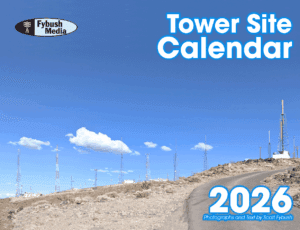
As we announced a few weeks ago, the 2026 edition of the Tower Site Calendar will be the last.
We began publishing it 25 years ago, and the broadcast landscape is radically different now.
Radio World just ran an excellent article about us if you want to know more.
Once it’s gone, that’s it. We won’t be printing any more.
Thank you to everyone who saw our announcement and rushed to buy it. We appreciate you.
(There are some calendars from previous years if you want more of a tower photo fix — all under $5.)
But don’t wait to get this year’s Tower Site Calendar — buy it now!
We are selling the Broadcast Historian’s Calendar again this year, but we have that in an even smaller quantity — definitely don’t hesitate for that.
And visit the Fybush Media Store to check out our selection of books and videos, too!
And don’t miss a big batch of Niagara Region IDs next Wednesday, over at our sister site, TopHour.com!
Next week: Downtown Toronto
In this week’s issue… Veteran newsman returns - Remembering NY's Leitner, RI's Jones - CT AM saved - Maine AM moves - "Indie" adds suburban signals
In this week’s issue… Scripps stations face takeover - Sinclair moves more affiliations - CT stations sold - Maine AM surrendered - Remembering WVBR's Shapiro, WABC's Morgan
In this week’s issue… CT TV legend succumbs to cancer - Remembering PA's Adams - FCC still stalled by shutdown - Pittsburgh morning host exits
In this week’s issue… FCC faces reopening challenges - Veteran Boston anchor retires - Morning shift in Toronto - NYC FMs expand reach